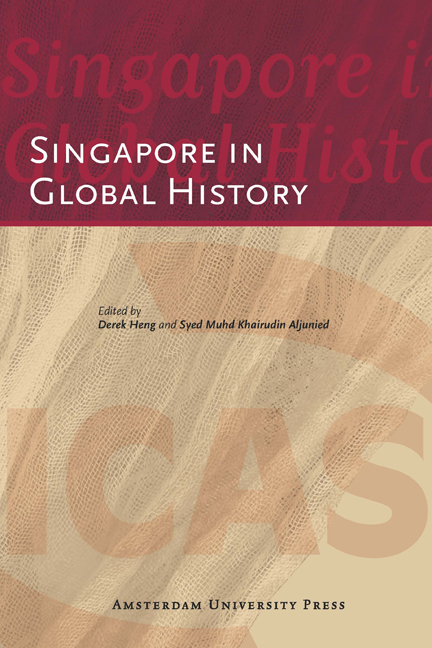Book contents
- Frontmatter
- Contents
- List of Tables and Illustrations
- Foreword
- 1 Globalising the History of Singapore
- 2 Situating Temasik within the Larger Regional Context: Maritime Asia and Malay State Formation in the Pre-Modern Era
- 3 The Singapore River/Port in a Global Context
- 4 ‘Walls of Illusion’: Information Generation in Colonial Singapore and the Reporting of the Mahdi-Rebellion in Sudan, 1887-1890
- 5 The Littoral and the Literary: Making Moral Communities in the Straits Settlements and the Gold Coast in the late Nineteenth and Early Twentieth Century
- 6 Social Discourse and Economic Functions: The Singapore Chinese in Japan’s Southward Expansion between 1914 and 1941
- 7 The Dynamics of Trans-Regional Business and National Politics: The Impact of Events in China on Fujian-Singapore Tea Trading Networks, 1920-1960
- 8 Rambutans in the Picture: Han Wai Toon and the Articulation of Space by the Overseas Chinese in Singapore
- 9 The Global Effects of an Ethnic Riot: Singapore, 1950-1954
- 10 The British Military Withdrawal from Singapore and the Anatomy of a Catalyst
- 11 Bringing the International and Transnational back in: Singapore, Decolonisation, and the Cold War
- 12 The Global and the Regional in Lee Kuan Yew’s Strategic Thought: The Early Cold War Years
- 13 A Brief History of the Hub: Navigating between ‘Global’ and ‘Asian’ in Singapore’s Knowledge Economy Discourse
- About the Contributors
- Bibliography
- Miscellaneous Endmatter
8 - Rambutans in the Picture: Han Wai Toon and the Articulation of Space by the Overseas Chinese in Singapore
Published online by Cambridge University Press: 02 February 2021
- Frontmatter
- Contents
- List of Tables and Illustrations
- Foreword
- 1 Globalising the History of Singapore
- 2 Situating Temasik within the Larger Regional Context: Maritime Asia and Malay State Formation in the Pre-Modern Era
- 3 The Singapore River/Port in a Global Context
- 4 ‘Walls of Illusion’: Information Generation in Colonial Singapore and the Reporting of the Mahdi-Rebellion in Sudan, 1887-1890
- 5 The Littoral and the Literary: Making Moral Communities in the Straits Settlements and the Gold Coast in the late Nineteenth and Early Twentieth Century
- 6 Social Discourse and Economic Functions: The Singapore Chinese in Japan’s Southward Expansion between 1914 and 1941
- 7 The Dynamics of Trans-Regional Business and National Politics: The Impact of Events in China on Fujian-Singapore Tea Trading Networks, 1920-1960
- 8 Rambutans in the Picture: Han Wai Toon and the Articulation of Space by the Overseas Chinese in Singapore
- 9 The Global Effects of an Ethnic Riot: Singapore, 1950-1954
- 10 The British Military Withdrawal from Singapore and the Anatomy of a Catalyst
- 11 Bringing the International and Transnational back in: Singapore, Decolonisation, and the Cold War
- 12 The Global and the Regional in Lee Kuan Yew’s Strategic Thought: The Early Cold War Years
- 13 A Brief History of the Hub: Navigating between ‘Global’ and ‘Asian’ in Singapore’s Knowledge Economy Discourse
- About the Contributors
- Bibliography
- Miscellaneous Endmatter
Summary
Around eighty percent of the estimated 25-30 million overseas Chinese in 140 countries around the world live in the countries that comprise Southeast Asia. (Wang 2005: 4) This large number is due to Southeast Asia's proximity to China, with outmigration from its southern coastal areas commencing around the 16th century at a time when the region's polities gradually became colonised or determined politically by European powers. The ratio of overseas Chinese to other ethnic populations in the region's nations has remained more or less constant through ensuing settlement, trade and social relations.
Up to now, scholarship on the space inhabited by the Chinese diaspora around the world has focused on sites of labour or enclaves known as ‘Chinatowns’ and the socio-economic spheres and built environments created in the new host cities as hybrid renditions. The coalescing of constitutive communities into a common ‘Chinese’ identity in those countries is an essential premise for such work. The overseas Chinese spaces or enclaves in Southeast Asia, however, need to be discussed differently from the Chinatowns of America, Australia or Europe because of their large populations, histories and spatial make-up.
The history of Singapore and its large ethnic Chinese population may be aligned along such a general narrative of diaspora in Southeast Asia. In this case, the British colonisers welcomed external populations in their colonies to drive imperial commerce and to compete and disrupt pre-existing local/regional economic patterns. From textual accounts, it is known that the human landscape soon after the establishment of the island's free port in 1819 was cosmopolitan, but the exponential increase in immigration from Southern China and the immigrants’ eventual control of various spheres of influence would alter the island's subsequent history. At the beginning of World War II, 43% of the population was registered as ethnically Chinese. This statistic is now about 75% and the Chinese are currently the majority ethnic category in censuses.
Chinese immigration to Singapore can be seen as a continual process since British colonisation in 1819. The first Chinese immigrants were mainly contract and indentured labour, but the communities grew and soon the need for schools to educate the locally-born was advanced.
- Type
- Chapter
- Information
- Singapore in Global History , pp. 151 - 172Publisher: Amsterdam University PressPrint publication year: 2012



